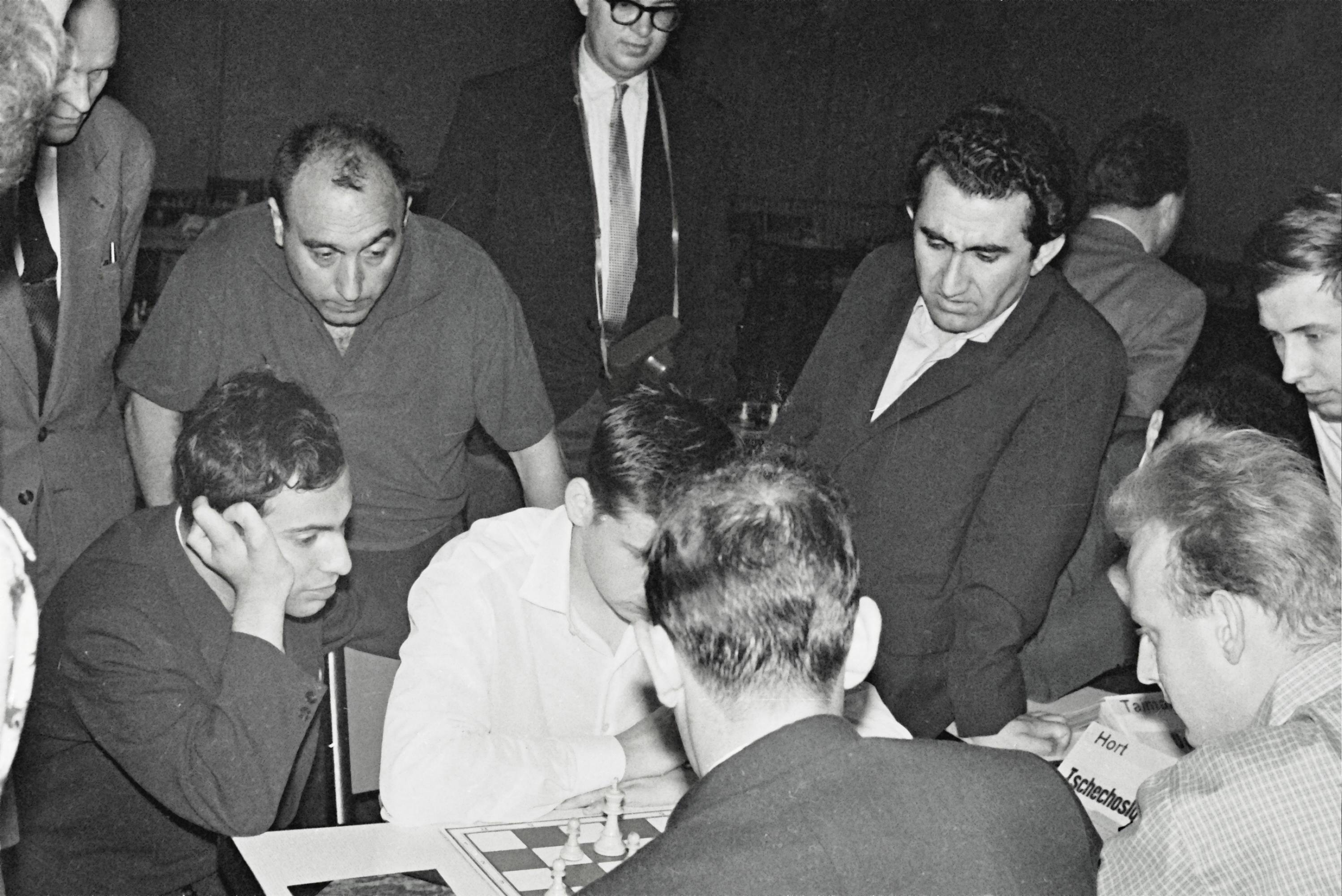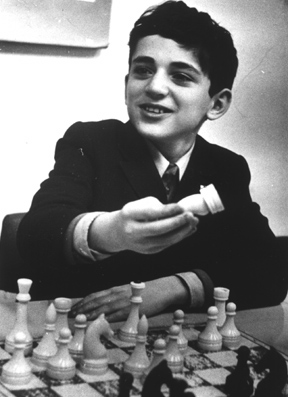|
Prophylaxis (chess)
In chess, prophylaxis consists of a move or series of moves done by a player to prevent their opponent from taking some action. Such preventive moves, or ''prophylactic moves'', aim not only to improve one's position but also to restrict the opponent in improving their own. Many standard and widespread opening moves can be considered prophylactic. One common prophylactic idea is the advance of the near a castled king, which can be done to provide luft and/or to prevent a pin; another is to transfer one's king to the b-file after castling queenside so as to protect an unmoved a-pawn, among other purposes. Prophylaxis is a distinctive feature of , often preventing opponents from entering risky, double-edged lines, as well as punishing opponents who play too aggressively. Using prophylaxis is an essential skill at advanced levels of play. Famous practitioners of prophylactic play include Aron Nimzowitsch, Tigran Petrosian, and Anatoly Karpov; even players, such as Mikhail Tal ... [...More Info...] [...Related Items...] OR: [Wikipedia] [Google] [Baidu] |
Chess
Chess is a board game for two players. It is an abstract strategy game that involves Perfect information, no hidden information and no elements of game of chance, chance. It is played on a square chessboard, board consisting of 64 squares arranged in an 8×8 grid. The players, referred to as White and Black in chess, "White" and "Black", each control sixteen Chess piece, pieces: one king (chess), king, one queen (chess), queen, two rook (chess), rooks, two bishop (chess), bishops, two knight (chess), knights, and eight pawn (chess), pawns, with each type of piece having a different pattern of movement. An enemy piece may be captured (removed from the board) by moving one's own piece onto the square it occupies. The object of the game is to "checkmate" (threaten with inescapable capture) the enemy king. There are also several ways a game can end in a draw (chess), draw. The recorded history of chess goes back to at least the emergence of chaturanga—also thought to be an ancesto ... [...More Info...] [...Related Items...] OR: [Wikipedia] [Google] [Baidu] |
Castling
Castling is a move in chess. It consists of moving the king (chess), king two squares toward a rook (chess), rook on the same and then moving the rook to the square that the king passed over. Castling is permitted only if neither the king nor the rook has previously moved; the squares between the king and the rook are vacant; and the king does not leave, cross over, or finish on a square attacked by an enemy piece. Castling is the only move in chess in which two pieces are moved at once. Castling with the is called ''kingside castling'', and castling with the is called ''queenside castling''. In both Algebraic notation (chess), algebraic and descriptive notation, descriptive notations, castling kingside is written as 0-0 and castling queenside as 0-0-0. Castling originates from the ''king's leap'', a two-square king move added to European chess between the 14th and 15th centuries, and took on its present form in the 17th century. Local variations in castling rules were ... [...More Info...] [...Related Items...] OR: [Wikipedia] [Google] [Baidu] |
Flight Square
In chess, a flight square or escape square is a safe square to which a piece, especially a king, can move if it is threatened. Providing one's piece with flight squares can prevent the opponent from winning material or delivering checkmate. For example, in the Morphy Defence, the white c-pawn may be advanced to provide the light-squared white bishop with a flight square. Conversely, it is possible to take away an enemy piece's flight squares, known as domination. Luft In chess, (the German word for "air", sometimes also "space" or "breath") designates the space or square left by a pawn move into which a king (usually a castled one) may then retreat, especially such a space made intentionally to avoid back-rank checkmate. A move leaving such a space is often said to "give the king some luft". The term "luft", "lufting", or "lufted" may also be used (as an English participle) to refer to the movement of the relevant pawn creating luft. (At the 45:26 mark, GM Ben Finegold ... [...More Info...] [...Related Items...] OR: [Wikipedia] [Google] [Baidu] |
Pin (chess)
In chess, a pin is a tactic in which a defending piece cannot move out of an attacking piece's line of attack without exposing a more valuable defending piece. Moving the attacking piece to effect the pin is called ''pinning''; the defending piece restricted by the pin is described as ''pinned''. Only a piece that can move any number of squares along a horizontal, vertical, or diagonal line (i.e. a bishop, rook, or queen) can pin. Any piece can be pinned except the king. The pin is one of the most powerful chess tactics. The inverse of a pin is a ''skewer'', in which a more valuable piece under direct attack may move to expose a less valuable piece to an attack. Types Absolute pin An ''absolute pin'' is one where the piece shielded by the pinned piece is the king. In this case it is illegal to move the pinned piece out of the line of attack, as that would place one's king in check (see diagram). A piece pinned in this way can still give check or defend another piece fr ... [...More Info...] [...Related Items...] OR: [Wikipedia] [Google] [Baidu] |
Aron Nimzowitsch
Aron Nimzowitsch (; , ''Aron Isayevich Nimtsovich''; 7 November 1886 – 16 March 1935) was a Latvian-born Danish chess player and writer. In the late 1920s, Nimzowitsch was one of the best chess players in the world. He was the foremost figure amongst the hypermoderns and wrote a very influential book on chess theory: '' My System'' (1925–1927). Nimzowitsch's seminal work ''Chess Praxis'', originally published in German in 1929, was purchased by a pre-teen and future World Champion Tigran Petrosian and was to have a great influence on his development as a chess player. Life Born in Riga, then part of the Russian Empire, the Jewish Yiddish-speaking Nimzowitsch came from a wealthy family, where he learned chess from his father Shaya Abramovich Nimzowitsch (1860, Pinsk – 1918), who was a timber merchant. By 1897, the family lived in Dvinsk. Mother's name: Esphir Nohumovna Nimzowitsch (born Rabinovich, 1865, Polotsk – 1937), sister – Tsilya-Kreyna Pevzner, broth ... [...More Info...] [...Related Items...] OR: [Wikipedia] [Google] [Baidu] |
Tigran Petrosian
Tigran Vardani Petrosian (; ; 17 June 1929 – 13 August 1984) was a Soviet-Armenian chess grandmaster and the ninth World Chess Champion from 1963 to 1969. He was nicknamed "Iron Tigran" due to his almost-impenetrable defensive playing style, which emphasized safety above all else. Petrosian is often credited with popularizing chess in Armenia. Petrosian was a candidate for the World Chess Championship on eight occasions (World Chess Championship 1954#1953 Candidates tournament, 1953, World Chess Championship 1957#1956 Candidates tournament, 1956, World Chess Championship 1960#1959 Candidates tournament, 1959, World Chess Championship 1963#Candidates Tournament, 1962, World Chess Championship 1972#1971 Candidates matches, 1971, World Chess Championship 1975#1974 Candidates tournament, 1974, World Chess Championship 1978#1977 Candidates tournament, 1977 and World Chess Championship 1981#1980/81 Candidates Tournament, 1980). He won the World Chess Championship 1963, World C ... [...More Info...] [...Related Items...] OR: [Wikipedia] [Google] [Baidu] |
Anatoly Karpov
Anatoly Yevgenyevich Karpov (, ; born May 23, 1951) is a Russian and former Soviet Grandmaster (chess), chess grandmaster, former World Chess Championship, World Chess Champion, and politician. He was the 12th World Chess Champion from 1975 to 1985, a three-time FIDE World Champion (1993, 1996, 1998), twice World Chess champion as a member of the USSR team (1985, 1989), and a six-time winner of Chess Olympiad, Chess Olympiads as a member of the USSR team (1972, 1974, 1980, 1982, 1986, 1988). The International Association of Chess Press awarded him nine Chess Oscars (1973–77, 1979, 1980, 1981, 1984). Karpov's chess tournament successes include over 160 first-place finishes. He had a peak Elo rating system, Elo rating of 2780, and his 102 total months world number one is the third-longest of all time, behind Magnus Carlsen and Garry Kasparov. Karpov is also an elected Member of the State Duma in Russia. Since 2006, he has chaired the Commission for Ecological Safety and Envir ... [...More Info...] [...Related Items...] OR: [Wikipedia] [Google] [Baidu] |
Mikhail Tal
Mikhail Tal (9 November 1936 – 28 June 1992) was a Soviet and Latvian chess player and the eighth World Chess Champion. He is considered a creative genius and is widely regarded as Comparison of top chess players throughout history, one of the most influential players in chess history. Tal played in an attacking and daring combinatorial style. His play was known above all for improvisation and unpredictability. Vladislav Zubok said of him, "Every game for him was as inimitable and invaluable as a poem". His nickname was "Misha (name), Misha", a diminutive for Michael (given name), Mikhail, and he earned the nickname "The Magician from Riga". Both ''The Mammoth Book of the World's Greatest Chess Games'' and ''Modern Chess Brilliancies'' include more games by Tal than any other player. He also held the record for the longest unbeaten streak in competitive chess history with 95 games (46 wins, 49 draws) between 23 October 1973 and 16 October 1974, until Ding Liren's streak o ... [...More Info...] [...Related Items...] OR: [Wikipedia] [Google] [Baidu] |
Garry Kasparov
Garry Kimovich Kasparov (born Garik Kimovich Weinstein on 13 April 1963) is a Russian Grandmaster (chess), chess grandmaster, former World Chess Champion (1985–2000), political activist and writer. His peak FIDE chess Elo rating system, rating of 2851, achieved in 1999, was the highest recorded until being surpassed by Magnus Carlsen in 2013. From 1984 until his retirement from regular competitive chess in 2005, Kasparov was ranked the world's No. 1 player for a record 255 months overall. Kasparov also #Other records, holds records for the most consecutive professional tournament victories (15) and Chess Oscars (11). Kasparov became the youngest undisputed world champion in World Chess Championship 1985, 1985 at age 22 by defeating then-champion Anatoly Karpov, a record he held until 2024, when Gukesh Dommaraju won the title at age 18. He defended the title against Karpov three times, in World Chess Championship 1986, 1986, World Chess Championship 1987, 1987 and World Ches ... [...More Info...] [...Related Items...] OR: [Wikipedia] [Google] [Baidu] |
Greek Language
Greek (, ; , ) is an Indo-European languages, Indo-European language, constituting an independent Hellenic languages, Hellenic branch within the Indo-European language family. It is native to Greece, Cyprus, Italy (in Calabria and Salento), southern Albania, and other regions of the Balkans, Caucasus, the Black Sea coast, Asia Minor, and the Eastern Mediterranean. It has the list of languages by first written accounts, longest documented history of any Indo-European language, spanning at least 3,400 years of written records. Its writing system is the Greek alphabet, which has been used for approximately 2,800 years; previously, Greek was recorded in writing systems such as Linear B and the Cypriot syllabary. The Greek language holds a very important place in the history of the Western world. Beginning with the epics of Homer, ancient Greek literature includes many works of lasting importance in the European canon. Greek is also the language in which many of the foundational texts ... [...More Info...] [...Related Items...] OR: [Wikipedia] [Google] [Baidu] |
Sicilian Defense, Najdorf Variation
The Najdorf Variation ( ) of the Sicilian Defence is one of the most popular, reputable, and deeply studied of all chess openings. ''Modern Chess Openings'' calls it the "Cadillac" or "Rolls-Royce" of chess openings. The opening is named after the Polish-Argentine grandmaster Miguel Najdorf, although he was not the first strong player to play the variation. Many players have relied on the Najdorf (notably Bobby Fischer and Garry Kasparov, although Kasparov would often transpose into a Scheveningen). The Najdorf begins: :1. e4 c5 :2. Nf3 d6 :3. d4 cxd4 :4. Nxd4 Nf6 :5. Nc3 a6 Black's 5...a6 aims to deny the b5-square to White's knights and light-square bishop while maintaining flexible . If Black plays 5...e5 immediately, then after 6.Bb5+ Bd7 (or 6...Nbd7 7.Nf5) 7.Bxd7+ Nbxd7 (or Qxd7) 8.Nf5, the knight on f5 is difficult to dislodge without concessions. Games in the Najdorf frequently feature opposite-side castling, where White and both sides launch simultaneous att ... [...More Info...] [...Related Items...] OR: [Wikipedia] [Google] [Baidu] |
The Oxford Companion To Chess
''The Oxford Companion to Chess'' is a reference book on the game of chess written by David Vincent Hooper and Kenneth Whyld. The book is written in an encyclopedia format. The book belongs to the Oxford Companions series. Details The first edition of the book was published in 1984 by Oxford University Press. The second edition (1992) has over 2,500 entries, including rules of chess, rules, list of chess terms, terms, chess strategy, strategies, chess tactics, tactics, over 500 brief biographies of famous players, and entries on more than 700 named chess opening, openings and opening variations. In the back of the book is a comprehensive index of opening variations and sub-variations, listing 1,327 named variations. The book also discusses variants from other countries (such as shogi or xiangqi), chess variants (such as three dimensional chess), and some forms of fairy chess. Editions * First published in 1984 by Oxford University Press * Reissued in paperback (with correction ... [...More Info...] [...Related Items...] OR: [Wikipedia] [Google] [Baidu] |




